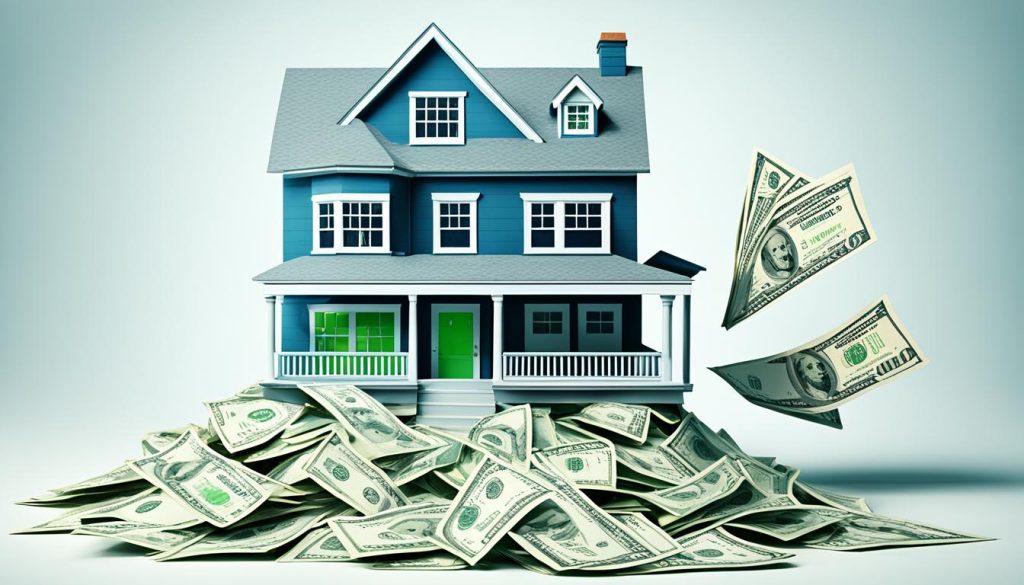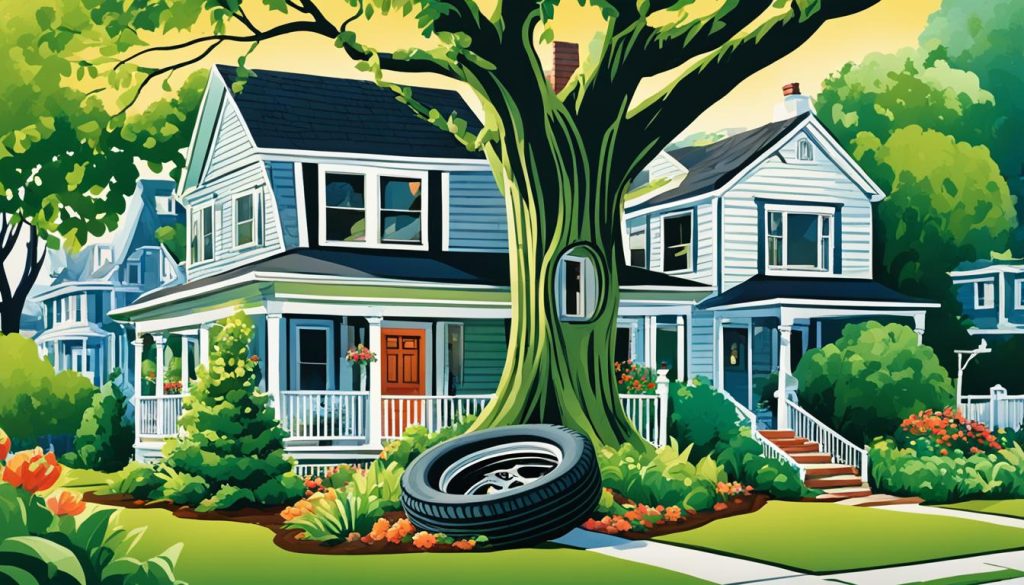Homeowners in the United States have seen their home equity grow a lot lately. Since the first quarter of 2023, it has increased by more than $1.5 trillion1. This means many homeowners can now tap into their home’s equity with a cash-out refinance. By refinancing your home for more money, you get the difference in cash. This cash can be used for home improvements, paying off debt, or other big expenses.
Key Takeaways
- Cash-out refinancing can provide access to up to 80-85% of your home’s value1
- Lenders typically require at least 15-20% equity to be maintained after a cash-out refinance1
- The cash-out refinance process can take 30-60 days to complete1
- Comparing rates, fees, and terms from at least three lenders is recommended1
- Cash-out refinancing can offer lower interest rates compared to credit cards and personal loans1
What is Cash-Out Refinancing?
Accessing Your Home’s Equity
Cash-out refinancing lets you tap into your home’s equity2. You can borrow up to 80% of your home’s equity with this type of refinance2. The amount you can get depends on your home’s LTV ratio and your credit score2.
Refinancing your home means getting a new loan to replace your old one, possibly with a different interest rate or term3. In a cash-out refinance, the new loan is bigger than your current mortgage, and you get the difference in cash3. Lenders usually let you take out 80% of your home’s value, but VA loans can go up to 100%3.
You can use this cash for home improvements, paying off debt, or saving for emergencies3. The cash can also help with big purchases, debt consolidation, or building an emergency fund2.
Remember, cash-out refinancing often means higher interest rates or more points than other types of refinancing2. It also comes with higher closing costs and interest rates because it’s riskier for the lender2.
| Loan Type | Maximum Loan-to-Value (LTV) Ratio |
|---|---|
| Conventional Cash-Out Refinance | Up to 80%4 |
| Multifamily Cash-Out Refinance | Up to 75%4 |
| FHA Cash-Out Refinance | Up to 80%4 |
| VA Cash-Out Refinance | Up to 100%4 |
When looking for a cash-out refinance, it’s key to compare rates and fees to understand the loan’s total cost2. To figure out your home equity, subtract your mortgage balance from your home’s market value2.
“The cash obtained from a cash-out refinance can be used for various purposes such as paying off debt, funding large purchases, or building an emergency fund.”
Cash-Out Refinancing: Pros and Cons
Cash-out refinancing has both good and bad sides. It lets you get a big sum of cash for different uses, often at a lower interest rate than other loans. This cash can be tax-deductible if you use it for home improvements5.
But, there are downsides too. It makes your total debt bigger and lowers your home equity. This could be a problem if your home’s value drops, leaving you owing more than your house is worth6.
To get a cash-out refinance, you usually need a credit score of 620 or higher for better rates7. Lenders also want your debt-to-income ratio to be 43% or less7. Be aware that closing costs for this refinance can be 2% to 6% of the loan amount7.
Deciding on a cash-out refinance should be based on your financial situation and goals. Make sure to think about both the good and bad sides before making a choice.
| Cash-Out Refinance Pros | Cash-Out Refinance Cons |
|---|---|
|
|
Choosing a cash-out refinance should be based on your financial situation and goals. It’s key to weigh the good and bad sides to make sure it’s right for you.

“Accessing your home’s equity through a cash-out refinance can be a valuable financial tool, but it’s crucial to understand the potential risks and consequences. Carefully consider your long-term financial goals and consult with a financial advisor before making a decision.”
There are other ways to use your home’s equity, like a home equity loan or a personal loan. Each option has its own pros and cons. The best choice depends on your specific needs and financial situation.
Cash-Out Refinancing
Thinking about a cash-out refinance? It’s key to know what you need to qualify. Lenders usually want your home equity to be at least 20% or more8. Your credit score is also important, needing a minimum of 640 for conventional cash-out refinances8. Plus, your debt-to-income (DTI) ratio should be under 43%, but some lenders might let it go up to 50% for cash-out refinances8.
How much equity you can use in a cash-out refinance matters too. Conventional and FHA loans let you borrow up to 80% of your home’s value8. But, VA cash-out refinances for military folks can reach up to 90%8. Remember, cash-out refinance rates are usually higher than regular refinance rates8. There might also be extra fees or points.
Timing and Loan Limits
Timing is crucial for a cash-out refinance. FHA and conventional loans wait for 12 months, while VA loans need 210 days8. Cash-out refinance limits also depend on conventional and FHA limits, which change yearly based on home prices8.
For a successful cash-out refinance, work closely with your lender. Check your credit score, home equity, and debt-to-income ratio. Knowing what you need to qualify helps you decide if a cash-out refinance is right for you.
Alternatives to Cash-Out Refinancing
If a cash-out refinance isn’t right for you, there are other ways to use your home’s equity. Home equity loans and home equity lines of credit (HELOCs) are faster and cheaper than cash-out refinancing but have higher interest rates9.
A home equity loan gives you a lump sum of cash. A HELOC lets you borrow against your equity as you need it. These options can be smarter ways to use your home’s value than cash-out refinancing910.
Home equity investments last 10 to 30 years, based on your home’s value9. Sale-leaseback agreements let you cash out equity while staying in your home as renters9.
Think about the good and bad of each option to find the best way to use your home’s equity. Home equity loans and HELOCs need less equity to borrow than cash-out refinances. But, cash-out refinances might offer lower interest rates10.
The choice between cash-out refinance and other options depends on your financial goals and situation. Talking to a financial advisor or a nonprofit credit counseling agency can help you pick the best option11.

“Accessing your home’s equity can be a powerful financial tool, but it’s important to carefully weigh the options and choose the one that best fits your needs.”
Conclusion
A cash-out refinance can be a strong tool for homeowners wanting to use their home’s equity. It lets you swap your old mortgage for a new, bigger one. This way, you get a cash sum for things like fixing up your home or paying off debts12.
But, it’s important to think about the downsides. These include taking on more debt, losing home equity, and possibly paying more in interest5. Before making a choice, look at other options like home equity loans, HELOCs, and short-term mortgages12.
Deciding on a cash-out refinance should be a careful process. Think about your financial goals, debts, and future plans. By looking at all the facts, you can pick the best option for your financial health7.
FAQ
What is cash-out refinancing?
Cash-out refinancing means you swap your old mortgage for a new one, but for more money. This lets you get cash from the difference. You can use this cash for whatever you want, like home improvements or paying off debt.
What are the advantages of a cash-out refinance?
The big plus of cash-out refinancing is getting a big sum of cash at a lower interest rate. If you use the money for home improvements, you might even get to deduct the interest on your taxes.
What are the disadvantages of a cash-out refinance?
The downsides include taking on more debt and losing some of your home’s equity. Make sure you think it through to see if it’s really worth it for your financial goals.
What are the requirements to qualify for a cash-out refinance?
You need a lot of equity in your home, usually over 20%. Your credit score, debt-to-income ratio, and steady income matter too. You can borrow up to 80% or 85% of your home’s value, so keep at least 15-20% equity left.
What are the alternatives to a cash-out refinance?
If cash-out refinancing isn’t right for you, consider a home equity loan or a HELOC. A home equity loan gives you a big sum of cash upfront. A HELOC lets you borrow against your equity as you need it, like a credit card. Both are faster and cheaper than refinancing but might have higher interest rates.
Source Links
- Pros and Cons of a Cash-Out Refinance | Bankrate
- Cash-Out Refinancing Explained: How It Works and When to Do It
- Cash-Out Refinance: Rates And Guide For Homeowners
- Cash-Out Refinancing: What It Is, How It Works | Bankrate
- The Pros and Cons of a Cash-Out Refinance
- Home Equity Loan vs. Cash-Out Refinance (2024 Guide)
- Cash-Out Refinance: Tap into Your Home Equity for Major Expenses
- Cash-Out Refinance: How It Works and When It’s a Good Idea
- How to Get Equity out of Your Home Without Refinancing
- Home Equity Loan Or HELOC Vs. Cash-Out Refinance | Bankrate
- Cash Out Refinancing: Pros, Cons, & Alternatives
- Key Takeaways

